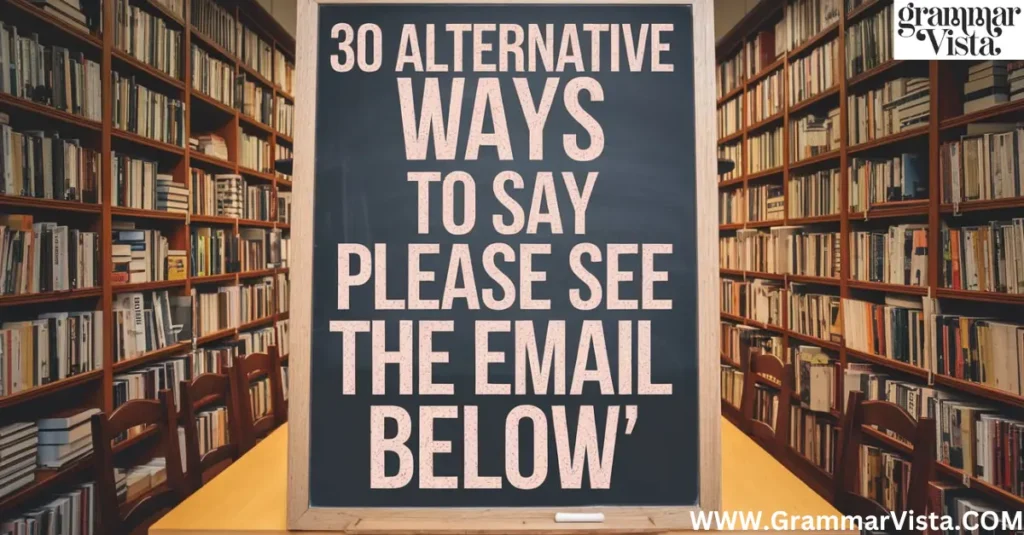In the fast-paced world of professional communication, we often find ourselves referencing previous emails. The phrase “Please see the email below” has become a staple in our digital conversations. However, using this repeated phrase can lead to monotony and potentially diminish the impact of our messages. Let’s explore ten alternative phrases that can enhance readability, improve tone, and build professional relationships while maintaining clarity and courtesy.
If you really want to know some alternative ways to say “please see the email below”, just scroll and keep reading continue!
Is it professional to say “Please See the Email Below”?
Several programs support Cross Copy and Paste features. Microsoft OneNote is well-known for this function. It allows users to copy data between various devices easily. Another option is Pushbullet. It connects your phone and computer for fast data transfer. Clipboard managers like Ditto also offer great functionality. They store copied items, making retrieval simple.
Yes! While “Please see the email below” is widely used in professional communication, it’s not always the most engaging or effective phrase. It’s functional but can sound repetitive and impersonal if overused. Opting for more varied and contextual alternatives can enhance readability, improve tone, and build professional relationships. These alternatives often provide clearer direction and show greater consideration for the recipient’s time and attention.
Here are 30 alternative ways to say “Please see the email below”
- “For your reference, I’ve included the previous email”
- “To provide context, here’s our earlier correspondence”
- “For a better understanding, I’m attaching our previous discussion”
- “Below, you’ll find the detailed information we discussed”
- “I’ve included our prior conversation for easy reference”
- “To jog your memory, here’s our last email exchange”
- “For continuity, I’ve appended our previous correspondence”
- “To keep you in the loop, here’s a recap of our last interaction”
- “For your records, I’m including our earlier exchange”
- “To refresh our discussion, I’ve attached the previous email”
- “I’ve threaded our previous conversation for context”
- “For a quick refresher, here’s our last email exchange”
- “To maintain continuity, I’ve included our prior discussion”
- “For your convenience, I’ve attached the relevant email thread”
- “To jog our collective memory, here’s a recap of our last correspondence”
- “I’ve appended our previous discussion for a comprehensive overview”
- “For seamless continuation, I’m including our earlier dialogue”
- “To connect the dots, here’s our previous interaction”
- “For a holistic view, I’ve incorporated our past exchange”
- “To ensure we’re on the same page, here’s a throwback to our last email”
- “For a trip down memory lane, I’ve attached our previous exchange”
- “To keep our conversation flowing, here’s a recap of our last chat”
- “For the sake of clarity, I’m looping in our previous correspondence”
- “To paint the full picture, I’ve included our earlier discussion”
- “For a blast from the (recent) past, here’s our last email interaction”
- “To connect the pieces of our conversation puzzle, I’ve attached our previous email”
- “For a seamless information flow, here’s a throwback to our last discussion”
- “To keep our ideas fresh in mind, I’m reattaching our previous conversation”
- “For a stroll through our communication history, I’ve included our last email”
- “To ensure we’re all on the same wavelength, here’s a rewind of our previous message”
These alternatives provide a variety of options to enhance readability, improve tone, and prevent monotony in your professional communication.
1. “For your reference, I’ve included the previous email”

This alternative phrase politely directs the recipient’s attention to the attached information without sounding too commanding. It builds professional rapport by implying that you’re providing helpful context.
Scenario: Imagine you’re following up with a client, Samantha, about a project proposal. You might write:
“Hi Samantha,
For your reference, I’ve included the previous email containing our initial project scope. I’d love to discuss any questions you might have about the proposal.
[Previous email]”
2. “To provide context, here’s our earlier correspondence”
This approach helps prevent monotony while emphasizing the importance of the previous message. It improves tone by showing that you’re thoughtfully providing background information.
Scenario: When updating a colleague on a ongoing task, you could say:
“Hey Alex,
To provide context, here’s our earlier correspondence about the marketing strategy. I’ve made some updates based on our last meeting.
[Previous email]”
3. “For a better understanding, I’m attaching our previous discussion”
This phrasing suggests that reviewing the earlier email will lead to improved comprehension, encouraging the recipient to pay attention to the details.
Scenario: When clarifying a complex issue with a team member, try:
“Hi Jordan,
For a better understanding of the technical requirements, I’m attaching our previous discussion with the IT department. Let me know if anything needs further explanation.
[Previous email]”
4. “Below, you’ll find the detailed information we discussed”

This alternative subtly guides the reader to the important content without explicitly telling them to “see” something. It enhances readability by setting clear expectations.
Scenario: When following up on a client meeting, you might write:
“Dear Mr. Thompson,
Below, you’ll find the detailed information we discussed regarding your investment options. I’ve highlighted the key points for your convenience.
[Previous email]”
5. “I’ve included our prior conversation for easy reference”
This phrase sounds helpful and considerate, implying that you’re making things easier for the recipient. It builds professional goodwill by showing thoughtfulness.
Scenario: When collaborating on a long-term project, you could say:
“Hello Emma,
I’ve included our prior conversation for easy reference as we move forward with the website redesign. This should help us stay aligned on the project goals.
[Previous email]”
Read More about Business’ or Business’s?
6. “To jog your memory, here’s our last email exchange”
This casual yet professional phrase adds a touch of friendliness to your message. It’s particularly useful when corresponding with someone you have a good rapport with.
Scenario: When following up with a regular client, try:
“Hi Sarah,
To jog your memory, here’s our last email exchange about your upcoming event. I’ve got some exciting updates to share!
[Previous email]”
7. “For continuity, I’ve appended our previous correspondence”
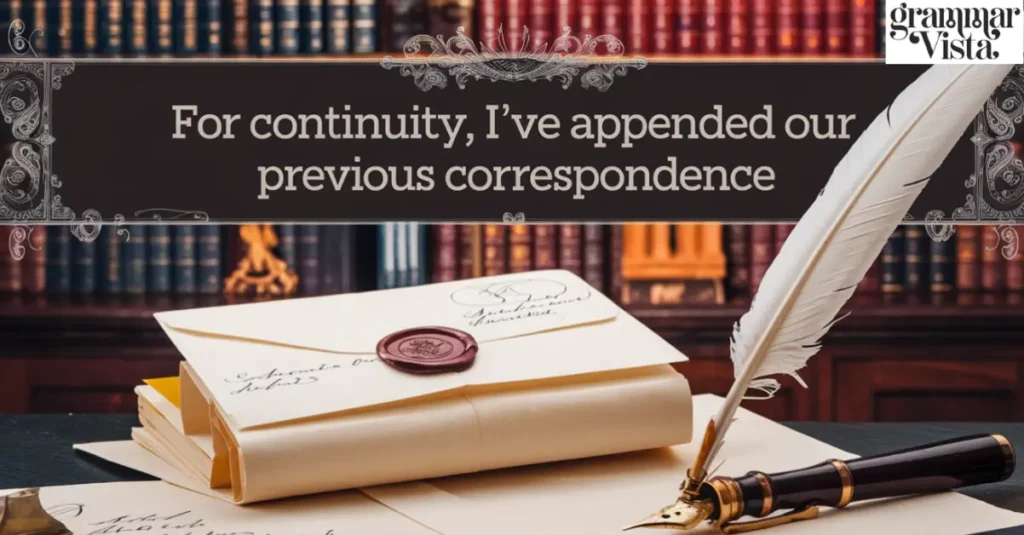
This more formal alternative is perfect for professional communication in corporate settings. It emphasizes the ongoing nature of your discussion and improves tone by sounding organized and thoughtful.
Scenario: When updating senior management on a project, you might write:
“Dear Mr. Chen,
For continuity, I’ve appended our previous correspondence regarding the Q3 financial projections. I’d like to discuss some new developments in our upcoming meeting.
[Previous email]”
8. “To keep you in the loop, here’s a recap of our last interaction”
This phrase is great for team communications, emphasizing inclusivity and information sharing. It builds professional relationships by showing that you value keeping everyone informed.
Scenario: When updating a colleague who’s been out of office, try:
“Welcome back, Lisa!
To keep you in the loop, here’s a recap of our last interaction about the client presentation. We’ve made some exciting progress while you were away.
[Previous email]”
9. “For your records, I’m including our earlier exchange”
This alternative is particularly useful when dealing with important or official matters. It suggests that the information might need to be saved or referenced later.
Scenario: When confirming details of a business agreement, you could write:
“Dear Ms. Rodriguez,
For your records, I’m including our earlier exchange about the terms of our partnership. Please let me know if you need any clarifications before we proceed to the next steps.
[Previous email]”
10. “To refresh our discussion, I’ve attached the previous email”
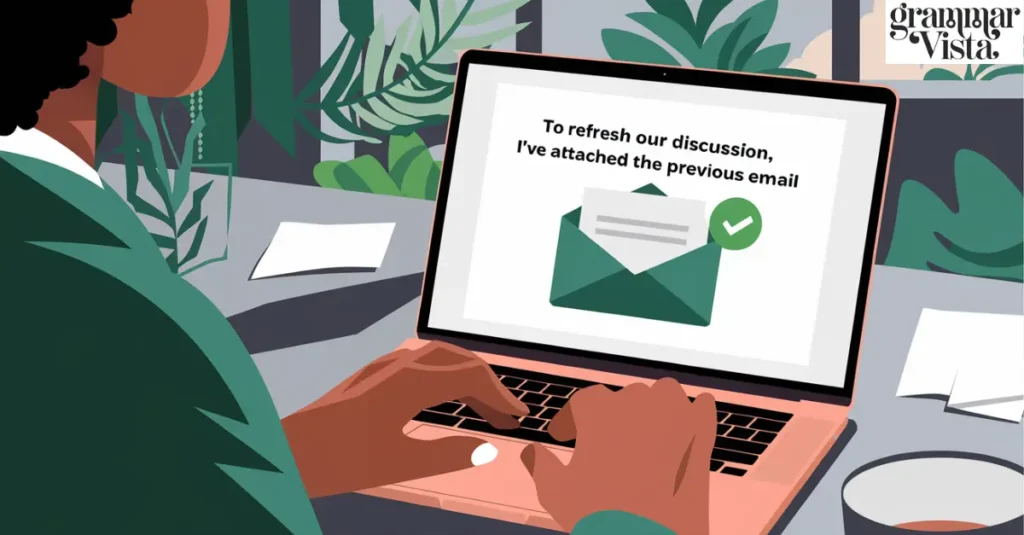
This phrase politely reminds the recipient of your ongoing conversation while providing the necessary context. It enhances readability by setting the stage for new information.
Scenario: When following up on a brainstorming session, try:
“Hi Team,
To refresh our discussion, I’ve attached the previous email summarizing our creative brainstorming session. I’m excited to hear your thoughts on the new ideas I’ll be presenting today.
[Previous email]”
11. “I’ve threaded our previous conversation for context”
This tech-savvy phrase acknowledges the digital nature of email communication while providing valuable information. It builds professional rapport by showing your organizational skills.
Scenario: When discussing a project update with a tech-oriented client, you might write:
“Hi Raj,
I’ve threaded our previous conversation for context about the app development milestones. Let’s discuss the new features we’ve implemented since then.
[Previous email]”
12. “For a quick refresher, here’s our last email exchange”
This casual yet professional phrase improves tone by acknowledging the fast-paced nature of business communication. It’s perfect for busy professionals who appreciate concise language.
Scenario: When following up on a sales lead, try:
“Hello Olivia,
For a quick refresher, here’s our last email exchange about your interest in our marketing services. I’m excited to share some new case studies that align with your goals.
[Previous email]”
13. “To maintain continuity, I’ve included our prior discussion”
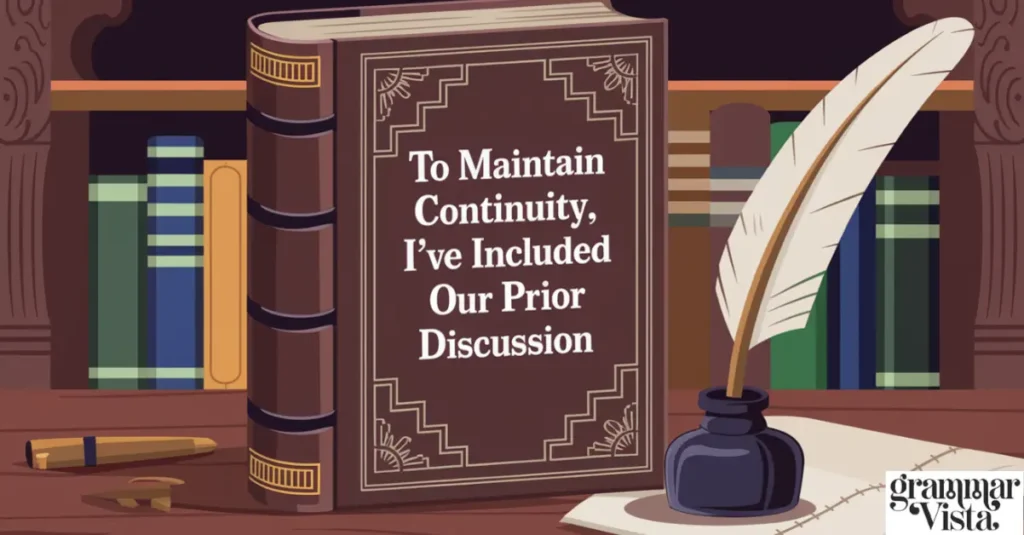
This alternative emphasizes the ongoing nature of your communication, which can be particularly useful in long-term projects or relationships. It builds professional trust by showing your commitment to consistent communication.
Scenario: When updating a long-term client on a multi-phase project, you could write:
“Dear Mr. Yamamoto,
To maintain continuity, I’ve included our prior discussion about Phase 1 of the office renovation. I’m pleased to report we’re ready to move on to Phase 2.
[Previous email]”
14. “For your convenience, I’ve attached the relevant email thread”
This phrase puts the focus on helping the recipient, which can improve tone and foster goodwill. It’s especially useful when dealing with complex or lengthy email chains.
Scenario: When clarifying a complicated issue with HR, try:
“Hi Priya,
For your convenience, I’ve attached the relevant email thread regarding the new remote work policy. I have a few questions about its implementation.
[Previous email]”
15. “To jog our collective memory, here’s a recap of our last correspondence”
This inclusive language is great for team communications. It builds professional camaraderie by implying shared responsibility and mutual engagement in the topic.
Scenario: When resuming a team project after a holiday break, you might say:
“Welcome back, team!
To jog our collective memory, here’s a recap of our last correspondence about the Q1 marketing campaign. Let’s pick up where we left off.
[Previous email]”
You might be interested in 15 Amazing Ways to Say “Well Noted” in an Email
16. “I’ve appended our previous discussion for a comprehensive overview”
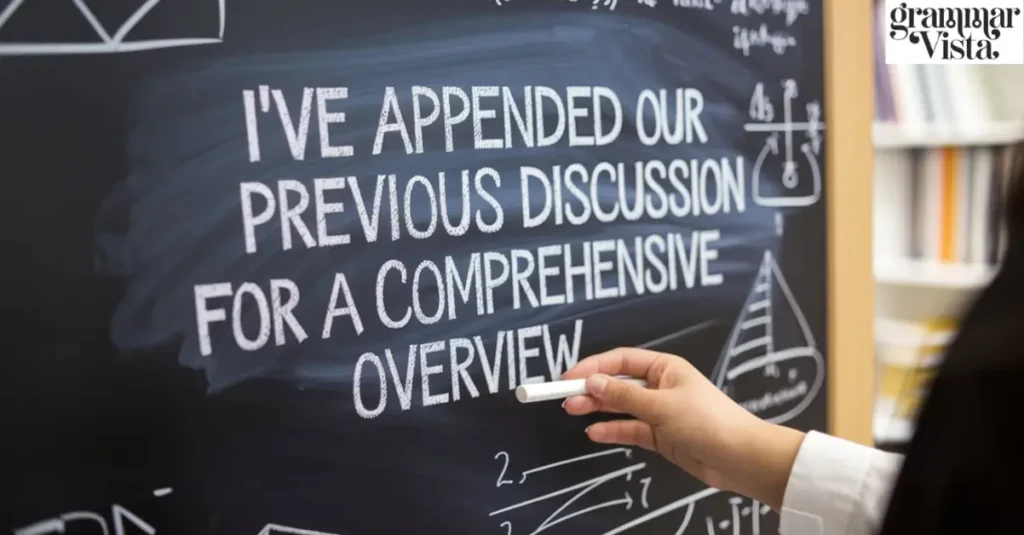
This more formal alternative is perfect for professional communication in academic or research settings. It emphasizes thoroughness and attention to detail.
Scenario: When collaborating on a research paper, you could write:
“Dear Dr. Chen,
I’ve appended our previous discussion for a comprehensive overview of our methodology. I’d like to propose some adjustments based on recent findings.
[Previous email]”
17. “For seamless continuation, I’m including our earlier dialogue”
This phrase emphasizes smooth communication flow, which can be particularly appreciated in fast-paced business environments. It improves tone by showing your commitment to efficient communication.
Scenario: When coordinating with a busy executive, try:
“Hello Ms. Thompson,
For seamless continuation, I’m including our earlier dialogue about the merger timeline. I have some updates that might affect our schedule.
[Previous email]”
18. “To connect the dots, here’s our previous interaction”
This casual yet effective phrase uses a common idiom to enhance readability and make your message more engaging. It’s great for creative or collaborative environments.
Scenario: When brainstorming with a marketing team, you might say:
“Hey creative geniuses!
To connect the dots, here’s our previous interaction about the new product launch campaign. I’ve had some wild ideas since then – can’t wait to hear yours!
[Previous email]”
19. “For a holistic view, I’ve incorporated our past exchange”

This alternative emphasizes completeness and thoroughness, which can be particularly valuable in strategic or analytical contexts. It builds professional credibility by demonstrating your comprehensive approach.
Scenario: When discussing a complex business strategy, try:
“Dear Board Members,
For a holistic view, I’ve incorporated our past exchange about the 5-year expansion plan. Today, I’d like to focus on how recent market changes might affect our strategy.
[Previous email]”
20. “To ensure we’re on the same page, here’s a throwback to our last email”
This phrase adds a touch of casual friendliness while still maintaining professionalism. It’s great for fostering a sense of teamwork and shared understanding.
Scenario: When coordinating with a cross-functional team, you could write:
“Hi all,
To ensure we’re on the same page, here’s a throwback to our last email about the cross-departmental initiative. Let’s discuss how each team’s progress aligns with our overall goals.
[Previous email]”
21. “For a trip down memory lane, I’ve attached our previous exchange”
This playful yet professional phrase adds a touch of lightheartedness to your communication while still maintaining a professional tone. It’s great for long-term professional relationships where a bit of familiarity is appropriate.
Scenario: When following up with a long-standing client, you might write:
“Hi Jessica,
For a trip down memory lane, I’ve attached our previous exchange about your company’s growth strategies. You won’t believe how far we’ve come since then!
[Previous email]”
22. “To keep our conversation flowing, here’s a recap of our last chat”
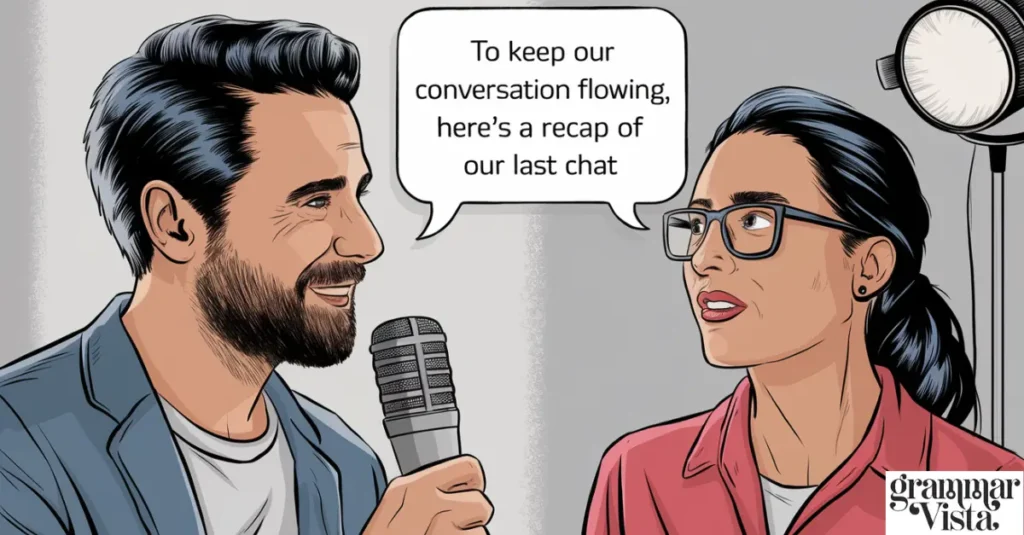
This alternative emphasizes continuity and engagement, which can improve tone by making your communication feel more like an ongoing dialogue rather than disjointed messages.
Scenario: When coordinating with a project team, try:
“Hey team,
To keep our conversation flowing, here’s a recap of our last chat about the product launch timeline. I’ve got some exciting updates to share!
[Previous email]”
23. “For the sake of clarity, I’m looping in our previous correspondence”
This phrase underscores your commitment to clear communication, which can build professional trust and demonstrate your attention to detail.
Scenario: When addressing a complex client query, you could write:
“Dear Mr. Tanaka,
For the sake of clarity, I’m looping in our previous correspondence about your custom software requirements. I believe this will help contextualize my proposed solutions.
[Previous email]”
24. “To paint the full picture, I’ve included our earlier discussion”
This alternative uses vivid language to enhance readability and engage your reader. It’s particularly useful when dealing with multifaceted topics or projects.
Scenario: When updating stakeholders on a complex project, try:
“Hello stakeholders,
To paint the full picture, I’ve included our earlier discussion about the citywide sustainability initiative. Let’s see how our recent progress fits into the broader vision.
[Previous email]”
25. “For a blast from the (recent) past, here’s our last email interaction”
This playful phrase adds a touch of humor to your professional communication, which can be refreshing in the right context. It’s best used with colleagues or clients with whom you have a good rapport.
Scenario: When reconnecting with a colleague after a short break, you might say:
“Welcome back, Chris!
For a blast from the (recent) past, here’s our last email interaction about the team building event. Ready to pick up where we left off?
[Previous email]”
26. “To connect the pieces of our conversation puzzle, I’ve attached our previous email”
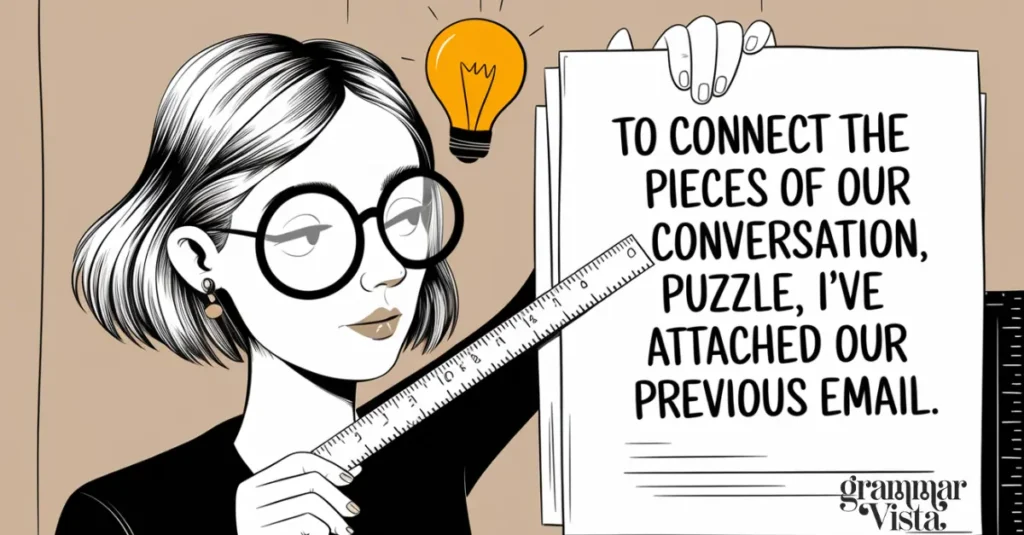
This creative alternative uses a metaphor to make your communication more engaging. It improves tone by implying that your ongoing conversation is building towards something meaningful.
Scenario: When collaborating on a complex research project, try:
“Hi Dr. Patel,
To connect the pieces of our conversation puzzle, I’ve attached our previous email about the experimental design. I think I’ve found the missing piece we’ve been looking for!
[Previous email]”
27. “For a seamless information flow, here’s a throwback to our last discussion”
This phrase emphasizes continuity and efficiency in communication, which can be particularly appreciated in fast-paced business environments. It builds professional credibility by showing your commitment to smooth information exchange.
Scenario: When updating a fast-moving startup team, you could write:
“Hey innovators,
For a seamless information flow, here’s a throwback to our last discussion about the app’s UX design. I’ve got some user feedback that might influence our direction.
[Previous email]”
28. “To keep our ideas fresh in mind, I’m reattaching our previous conversation”
This alternative acknowledges the challenge of keeping track of multiple conversations and shows consideration for your recipient’s time and mental load. It enhances readability by providing context upfront.
Scenario: When following up on a brainstorming session, try:
“Hello creative team,
To keep our ideas fresh in mind, I’m reattaching our previous conversation about the holiday marketing campaign. Let’s build on these concepts in today’s meeting.
[Previous email]”
29. “For a stroll through our communication history, I’ve included our last email”
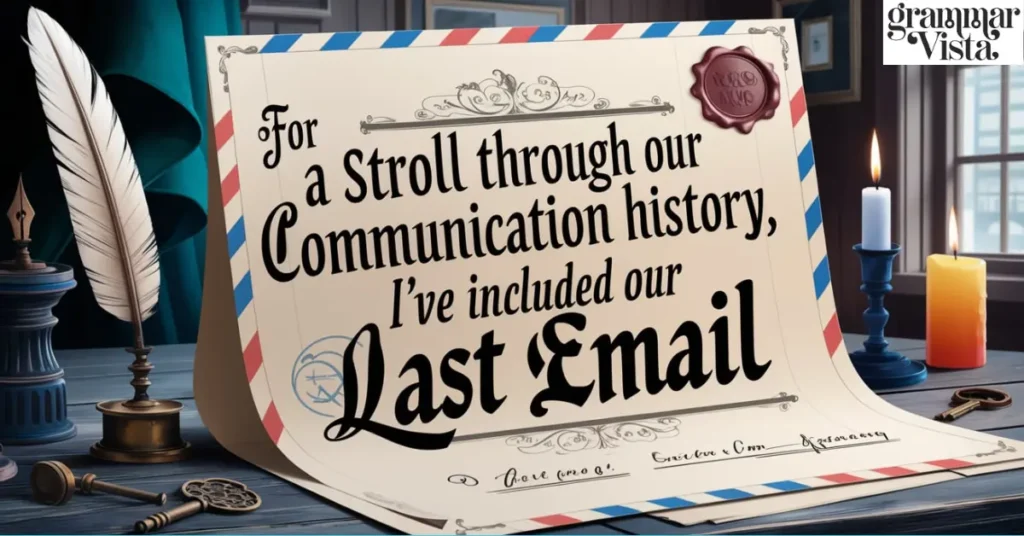
This phrase adds a touch of whimsy to your professional communication while still maintaining clarity. It’s great for fostering a sense of shared history and ongoing collaboration.
Scenario: When touching base with a mentor or long-term professional contact, you might say:
“Dear Sarah,
For a stroll through our communication history, I’ve included our last email about career development strategies. I’m excited to share how your advice has shaped my path!
[Previous email]”
30. “To ensure we’re all on the same wavelength, here’s a rewind of our previous message”
This alternative uses a radio metaphor to improve tone and add a bit of personality to your communication. It emphasizes alignment and shared understanding.
Scenario: When coordinating with a diverse team on a project, try:
“Hi global team,
To ensure we’re all on the same wavelength, here’s a rewind of our previous message about the international product rollout. Let’s sync up on our progress across different time zones.
[Previous email]”
Read More grammar lessons on GrammarVista
Conclusion: Elevating Your Email Communication
By employing these alternative phrases to “Please see the email below,” you can significantly improve tone and enhance readability in your professional communication. These variations help prevent monotony and demonstrate your commitment to clear, effective messaging. Remember, the key to successful email communication lies not just in the words you choose, but in how you use them to build professional relationships. Each of these alternatives serves to guide your recipient’s attention to important information while maintaining a courteous and engaging tone.
As you incorporate these phrases into your daily correspondence, you’ll likely notice an improvement in how your messages are received and acted upon. The clarity and courtesy inherent in these alternatives can lead to a better understanding between you and your recipients, ultimately strengthening your professional connections. In the end, effective communication is about more than just conveying information, it’s about building relationships, fostering understanding, and driving action.

